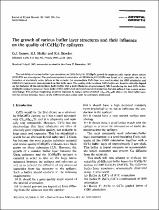 ResearchSpace
ResearchSpace
The growth of various buffer layer structures and their influence on the quality of (CdHg)Te epilayers
JavaScript is disabled for your browser. Some features of this site may not work without it.
- ResearchSpace
- →
- Research Publications/Outputs
- →
- Journal Articles
- →
- View Item
| dc.contributor.author |
Gouws, GJ

|
en_US |
| dc.contributor.author |
Muller, RJ

|
en_US |
| dc.contributor.author |
Bowden, RS

|
en_US |
| dc.date.accessioned | 2007-01-20T12:42:51Z | en_US |
| dc.date.accessioned | 2007-06-07T10:03:09Z | |
| dc.date.available | 2007-01-20T12:42:51Z | en_US |
| dc.date.available | 2007-06-07T10:03:09Z | |
| dc.date.copyright | en_US | |
| dc.date.issued | 1993-05 | en_US |
| dc.identifier.citation | Gouws, GJ, Muller, RN and Bowden, RS. 1993. The growth of various buffer layer structures and their influence on the quality of (CdHg)Te epilayers. Journal of Crystal Growth, vol. 130, 02 january, pp 209-216 | en_US |
| dc.identifier.issn | 0022-0248 | en_US |
| dc.identifier.uri | http://hdl.handle.net/10204/1431 | en_US |
| dc.identifier.uri | http://hdl.handle.net/10204/1431 | |
| dc.description.abstract | The suitability of various buffer layer structures on (100) GaAs for (CdHg)Te growth by organometallic vapour phase epitaxy (OMVPE) was investigated. The preferred epitaxial orientation of (100) GaAs/ (lll) CdTe was found to be unsuitable due to the formation of electrically active defects in the material. An intermediate ZnTe layer was used to select the (100) orientation and (100) CdTe layers were then deposited on this ZnTe layer. The quality of the resultant CdTe buffer was found to critically depend on the thickness of this intermediate ZnTe buffer, with a ZnTe thickness of approximately 500 angstrom producing the best CdTe buffer. (CdHg)Te epilayers grown on these ZnTe/CdTe buffers had improved electrical properties, but still suffered from a poor surface morphology. This surface morphology could be improved by using a lattice matched Cd0.96Zn0.04Te alloy as the final buffer layer, but the surface pyramids typical of the (100) orientation could never be completely eliminated. | en_US |
| dc.format.extent | 3068044 bytes | en_US |
| dc.format.mimetype | application/pdf | en_US |
| dc.language.iso | en | en_US |
| dc.publisher | Elsevier Science BV | en_US |
| dc.rights | Copyright: 1993 Elsevier Science BV | en_US |
| dc.source | en_US | |
| dc.subject | (CdHg)Te epilayers | en_US |
| dc.subject | ZnTe buffer | en_US |
| dc.subject | CdTe buffer | en_US |
| dc.subject | OMVPE | en_US |
| dc.subject | Organometalic vapour phase epitaxy | en_US |
| dc.subject | Buffer layers | en_US |
| dc.subject | Crystallography | en_US |
| dc.title | The growth of various buffer layer structures and their influence on the quality of (CdHg)Te epilayers | en_US |
| dc.type | Article | en_US |
| dc.identifier.apacitation | Gouws, G., Muller, R., & Bowden, R. (1993). The growth of various buffer layer structures and their influence on the quality of (CdHg)Te epilayers. http://hdl.handle.net/10204/1431 | en_ZA |
| dc.identifier.chicagocitation | Gouws, GJ, RJ Muller, and RS Bowden "The growth of various buffer layer structures and their influence on the quality of (CdHg)Te epilayers." (1993) http://hdl.handle.net/10204/1431 | en_ZA |
| dc.identifier.vancouvercitation | Gouws G, Muller R, Bowden R. The growth of various buffer layer structures and their influence on the quality of (CdHg)Te epilayers. 1993; http://hdl.handle.net/10204/1431. | en_ZA |
| dc.identifier.ris | TY - Article AU - Gouws, GJ AU - Muller, RJ AU - Bowden, RS AB - The suitability of various buffer layer structures on (100) GaAs for (CdHg)Te growth by organometallic vapour phase epitaxy (OMVPE) was investigated. The preferred epitaxial orientation of (100) GaAs/ (lll) CdTe was found to be unsuitable due to the formation of electrically active defects in the material. An intermediate ZnTe layer was used to select the (100) orientation and (100) CdTe layers were then deposited on this ZnTe layer. The quality of the resultant CdTe buffer was found to critically depend on the thickness of this intermediate ZnTe buffer, with a ZnTe thickness of approximately 500 angstrom producing the best CdTe buffer. (CdHg)Te epilayers grown on these ZnTe/CdTe buffers had improved electrical properties, but still suffered from a poor surface morphology. This surface morphology could be improved by using a lattice matched Cd0.96Zn0.04Te alloy as the final buffer layer, but the surface pyramids typical of the (100) orientation could never be completely eliminated. DA - 1993-05 DB - ResearchSpace DP - CSIR KW - (CdHg)Te epilayers KW - ZnTe buffer KW - CdTe buffer KW - OMVPE KW - Organometalic vapour phase epitaxy KW - Buffer layers KW - Crystallography LK - https://researchspace.csir.co.za PY - 1993 SM - 0022-0248 T1 - The growth of various buffer layer structures and their influence on the quality of (CdHg)Te epilayers TI - The growth of various buffer layer structures and their influence on the quality of (CdHg)Te epilayers UR - http://hdl.handle.net/10204/1431 ER - | en_ZA |





